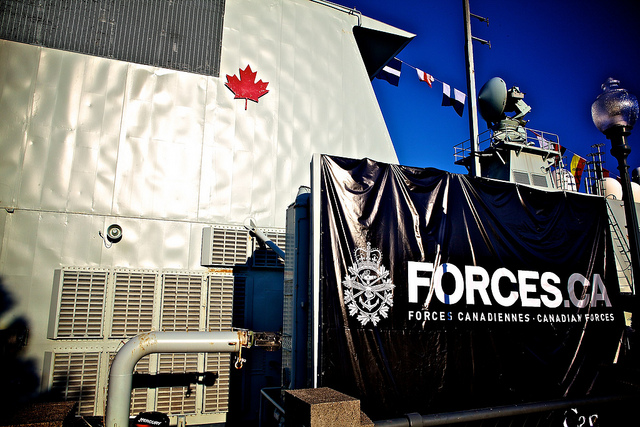Chip in to keep stories like these coming.
The Conservative government’s self-proclaimed competence as an economic and fiscal manager has come under sharp criticism from many quarters. One area where the gap between rhetoric and reality has received less attention is its management of military equipment procurement.
That is sure to change with this week’s news that the Navy’s Canadian Surface Combatant program is at “very high risk” of running over budget and way behind schedule, and new suggestions the F-35 fighter jet is now unaffordable because of Canada’s low dollar.
These are just the tip of an iceberg that’s been blocking military upgrades for some time now.
According to a Radio Canada Enquête investigation, there has been a spectacular increase in secretive sole source defence contracts issued under the Harper government. A major beneficiary has been General Dynamics, which received $4.3 billion in contracts of which 95 per cent were sole source; that is, not won through an open competitive bidding process.
The list of military procurement debacles since 2006 is long. In a series of reports for the CCPA and the Rideau Institute, Michael Byers and Stewart Webb have documented initiatives to replace military equipment gone awry due to mismanagement and neglect. Byers summarizes them in the following excerpt from his report Smart Defence: A plan for rebuilding Canada’s military, released by the CCPA and Rideau Institute in June 2015 (p. 10):
In 2006, the Harper government first issued a “request for proposals” to replace the Navy’s rusting-out supply ships. Since then, the project has been cancelled and restarted, and the Navy has had to retire both ships without replacements in sight. New vessels are now planned for 2021, postponing the $2.6 billion expense until then.
In 2006, the Harper government also promised 1,300 armoured trucks to replace a fleet the Army warned was at risk of “catastrophic failure.” To date, no manufacturer has been selected and $800 million remains unspent.
At the same time, the government promised search-and-rescue planes to replace the Air Force’s half-century old fleet. Once again, no contract has been signed, leaving $1.9 billion unspent.
In 2007, Harper personally promised the Navy six to eight Arctic/Offshore Patrol Ships. A construction contract was signed in January 2015, but for only five to six vessels. And the $3.5-billion expense — up from the $3.1 billion initially projected — will not actually be counted until well after the election.
In 2010, the Harper government announced that 65 F-35 Strike Fighter jets would be purchased to replace the three-decade old CF-18s, with a life-cycle cost of $16 billion. But no contract was signed and the decision was postponed after it was revealed that the life-cycle cost would be closer to $45 billion — and quite possibly much higher.
In 2011, the Harper government announced that the Navy’s destroyers and frigates would be replaced with 15 new Canadian Surface Combatants. In 2014, the Navy retired two of its three remaining destroyers, HMCS Iroquois and HMCS Algonquin, because of rust damage to their hulls.
In January 2015, the government signed a $26-billion uncompetitive, sole-source contract with Irving Shipbuilding for the Canadian Surface Combatants, making it the principal contractor for the project. But with no deliveries expected until at least 2025, the $26-billion cost will not appear on any federal budget during this decade.
Finally, there is the enduring effort to replace the half-century-old Sea King maritime helicopters. The Martin government signed a contract for Cyclone helicopters in 2004, with deliveries promised for 2009. The Harper government renegotiated the contract in 2014, relaxing some of the safety requirements. It also permitted the delivery date of fully complete Cyclones to slide to 2018, thereby delaying more than $1 billion in spending until then.
Whether or not some or all of these deferred military equipment expenditures are necessary and appropriate, Byers estimates they amount to $40 billion.
The Harper government’s tax cuts have so diminished federal fiscal capacity — reduced by over $40 billion per year — that future governments will have to scale back and re-prioritize these military equipment plans. They will also have to compete with major social and economic priorities that are the result of a decade of government neglect and cuts.
Stuart Trew is the editor of the CCPA Monitor.
Photo: Patrick Cardinal/flickr
Chip in to keep stories like these coming.




